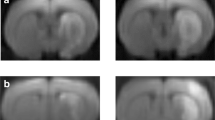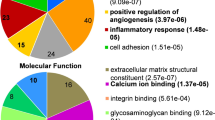Abstract
Due to its nootropic, neuroprotective, and immunomodulatory effects, the peptide Semax is utilized in the treatment of ischemic stroke. Our earlier RNA-Seq analysis of the transcriptome in an ischemic model of transient occlusion of the middle cerebral artery showed an increase in the mRNA levels of many proinflammatory genes, and the suppression of their induction by Semax. However, for many relevant genes, including Il1a, Il1b, Il6 and Tnfa, the levels of their expression were too low for detailed quantitative evaluation. Here we utilize qRT-PCR to analyze the effects of the Semax peptide on the expression of weakly expressed mRNAs encoding several proinflammatory mediators, and show that exposure to Semax leads to a statistically significant decrease in the Il1a, Il1b, Il6, Ccl3, and Cxcl2 mRNAs, which compensates for the increase in the transcription of these genes induced by ischemia-reperfusion. We conclude that the observed protective effect of Semax in the model of stroke may be due to its anti-inflammatory effects. We also discuss the limitations of the RNA-Seq when applied to quantifying less abundant transcripts as compared to the real-time RT-PCR method.



Similar content being viewed by others
REFERENCES
Lambertsen K.L., Biber K., Finsen B. 2012. Inflammatory cytokines in experimental and human stroke. J. Cereb. Blood Flow Metab. 32 (9), 1677–1698.
Fouda A.Y., Kozak A., Alhusban A., Switzer J.A., Fagan S.C. 2013. Anti-inflammatory IL-10 is upregulated in both hemispheres after experimental ischemic stroke: Hypertension blunts the response. Exp. Transl. Stroke Med. 5 (1), 12.
Jayaraj R.L., Azimullah S., Beiram R., Jalal F.Y., Rosenberg G.A. 2019. Neuroinflammation: Friend and foe for ischemic stroke. J. Neuroinflamm. 16 (1), 142.
Ramiro L., Simats A., García-Berrocoso T., Montaner J. 2018. Inflammatory molecules might become both biomarkers and therapeutic targets for stroke management. J. Ther. Adv. Neurol. Disord. 11, 1756286418789340.
Boutin H., LeFeuvre R.A., Horai R., Asano M., Iwakura Y., Rothwell N.J. 2001. Role of IL-1alpha and IL‑1beta in ischemic brain damage. J. Neurosci. 21 (15), 5528–5534.
Zhai Q.H., Futrell N., Chen F.J. 1997. Gene expression of IL-10 in relationship to TNF-alpha, IL-1beta and IL-2 in the rat brain following middle cerebral artery occlusion. J. Neurol. Sci. 152 (2), 119–124.
Schroeter M., Küry P., Jander S. 2003. Inflammatory gene expression in focal cortical brain ischemia: Differences between rats and mice. Brain Res. Mol. Brain Res. 117 (1), 1–7.
Vikman P., Ansar S., Henriksson M., Stenman E., Edvinsson L. 2007. Cerebral ischemia induces transcription of inflammatory and extracellular-matrix-related genes in rat cerebral arteries. Exp. Brain Res. 183 (4), 499–510.
Reichel C.A., Rehberg M., Lerchenberger M., Berberich N., Bihari P., Khandoga A.G., Zahler S., Krombach F. 2009. Ccl2 and Ccl3 mediate neutrophil recruitment via induction of protein synthesis and generation of lipid mediators. Arterioscler. Thromb. Vasc. Biol. 29 (11), 1787–1793.
Lee S., Chu H.X., Kim H.A., Real N.C., Sharif S., Fleming S.B., Mercer A.A., Wise L.M., Drummond G.R., Sobey C.G. 2015. Effect of a broad-specificity chemokine-binding protein on brain leukocyte infiltration and infarct development. Stroke. 46 (2), 537–544.
Zaremba J., Ilkowski J., Losy J. 2006. Serial measurements of levels of the chemokines CCL2, CCL3 and CCL5 in serum of patients with acute ischaemic stroke. Folia Neuropathol. 44 (4), 282–289.
de Wied D. 1997. Neuropeptides in learning and memory processes, Behav. Brain Res. 83, 83–90.
Grivennikov I.A., Dolotov O.V., Gol’dina Yu.I. 1999. Peptide factors in proliferation, differentiation, and viability of the cells of mammalian nervous system. Mol. Biol. (Moscow). 33 (1), 103–108.
Kolomin T., Shadrina M., Slominsky P., Limborska S., Myasoedov N. 2013. A new generation of drugs: synthetic peptides based on natural regulatory peptides, Neurosci. Med. 4, 223–252.
Dmitrieva V.G., Povarova O.V., Skvortsova V.I., Limborska S.A., Myasoedov N.F., Dergunova L.V. 2010. Semax and Pro-Gly-Pro activate the transcription of neurotrophins and their receptor genes after cerebral ischemia. Cell. Mol. Neurobiol. 30 (1), 71–79.
Stavchansky V.V., Yuzhakov V.V., Botsina A.Y., Skvortsova V.I., Bondurko L.N., Tsyganova M.G., Limborska S.A., Myasoedov N.F., Dergunova L.V. 2011. The effect of Semax and its C-end peptide PGP on the morphology and proliferative activity of rat brain cells during experimental ischemia: a pilot study. J. Mol. Neurosci. 45, 177–185.
Medvedeva E.V., Dmitrieva V.G., Povarova O.V., Limborska S.A., Skvortsova V.I., Myasoedov N.F., Dergunova L.V. 2014. The peptide semax affects the expression of genes related to the immune and vascular systems in rat brain focal ischemia: genome-wide transcriptional analysis. BMC Genomics. 15, 228.
Medvedeva E.V., Dmitrieva V.G., Limborska S.A., Myasoedov N.F., Dergunova L.V. 2017. Semax, an analog of ACTH(4–7), regulates expression of immune response genes during ischemic brain injury in rats. Mol. Genet. Genomics. 292 (3), 635–653.
Dergunova L.V., Filippenkov I.B., Stavchansky V.V., Denisova A.E., Yuzhakov V.V., Mozerov S.A., Gubsky L.V., Limborska S.A. 2018. Genome-wide transcriptome analysis using RNA-Seq reveals a large number of differentially expressed genes in a transient MCAO rat model. BMC Genomics. 19 (1), 655.
Filippenkov I.B., Stavchansky V.V., Denisova A.E., Yuzhakov V.V., Sevan’kaeva L.E., Sudarkina O.Yu., Dmitrieva V.G., Gubsky L.V., Myasoedov N.F., Limborska S.A., Dergunova L.V. 2020. Novel insights into the protective properties of ACTH(4–7)PGP (Semax) peptide at the transcriptome level following cerebral ischaemia-reperfusion in rats. Genes (Basel). 11 (6), E681.
Costa C., Giménez-Capitán A., Karachaliou N., Rosell R. 2013. Comprehensive molecular screening: from the RT-PCR to the RNA-seq. Transl. Lung Cancer Res. 2 (2), 87–91.
Garcia J.H., Liu K.F., Ho K.L. 1995. Neuronal necrosis after middle cerebral artery occlusion in Wistar rats progresses at different time intervals in the caudoputamen and the cortex. Stroke. 26 (4), 636–642
Li Y., Powers C, Jiang N., Chopp M. 1998. Intact, injured, necrotic and apoptotic cells after focal cerebral ischemia in the rat. J. Neurol. Sci. 156 (2), 119–132.
Lipton P. Ischemic cell death in brain neurons. 1999. Physiol. Rev. 79 (4), 1431–1568.
Paxinos G., Watson C. 1997. The Rat Brain in Stereotaxic Coordinates, 3rd ed. San Diego: Academic.
Nieswandt B., Kleinschnitz C., Stoll G. 2011. Ischaemic stroke: A thrombo-inflammatory disease? J. Physiol. 589 (17), 4115–4123.
Ryang Y.M., Dang J., Kipp M., Petersen K.U., Fahlenkamp A.V., Gempt J., Wesp D., Rossaint R., Beyer C., Coburn M. 2011. Solulin reduces infarct volume and regulates gene-expression in transient middle cerebral artery occlusion in rats. BMC Neurosci. 12, 113.
Canazza A., Minati L., Boffano C., Parati E., Binks S. 2014. Experimental models of brain ischemia: A review of techniques, magnetic resonance imaging, and investigational cell-based therapies. Front. Neurol. 5, 19.
Stark R., Grzelak M., Hadfield J. 2019. RNA sequencing: the teenage years. Nat. Rev. Genet. 20 (11), 631–656.
Hitzemann R., Bottomly D., Darakjian P., Walter N., Iancu O. Searles R. Wilmot B. McWeeney S. 2013. Genes, behavior and next-generation RNA sequencing. Genes Brain Behav. 12, 1–12.
Hart T., Komori H.K., LaMere S., Podshivalova K., Salomon D.R. 2013. Finding the active genes in deep RNA-seq gene expression studies. BMC Genomics. 14, 778.
Koch C.M., Chiu S.F., Akbarpour M., Bharat A., Ridge K.M., Bartom E.T., Winter D.R. 2018. A beginner’s guide to analysis of RNA sequencing data. Am. J. Respir. Cell Mol. Biol. 59, 145–157.
Ramsköld D., Wang E.T., Burge C.B., Sandberg R. 2009. An abundance of ubiquitously expressed genes revealed by tissue transcriptome sequence data. PLoS Comput. Biol. 5, e1000598.
Funding
The work was supported by the Russian Science Foundation, project no. 19-14-00268.
Author information
Authors and Affiliations
Corresponding author
Ethics declarations
Conflict of interests. The authors declare that they have no conflict of interest.
Statement on the welfare of animals. All procedures involving animals were performed in compliance with ethical standards of the facilities or established practices of such experiments.
Additional information
Translated by A. Deryabina
Abbreviations: ACTH, adrenocorticotropic hormone; DEGs, differentially expressed genes; MRI, magnetic resonance imaging; MCA, middle cerebral artery; 3D-TOF MRA, three-dimensional time-of-flight magnetic resonance angiography; ADC, apparent diffusion coefficient; Ct, amplification cycle threshold; DWI, diffusion-weighted imaging; FPKM, fragments per kilobase per million reads; PGP, Pro-Gly-Pro; pMCAO, permanent middle cerebral artery occlusion model; RNA-Seq, high throughput RNA sequencing; T2 WI, T2-weighted transverse image; tMCAO, transient middle cerebral artery occlusion model.
Rights and permissions
About this article
Cite this article
Dergunova, L.V., Dmitrieva, V.G., Filippenkov, I.B. et al. The Peptide Drug ACTH(4–7)PGP (Semax) Suppresses mRNA Transcripts Encoding Proinflammatory Mediators Induced by Reversible Ischemia of the Rat Brain. Mol Biol 55, 346–353 (2021). https://doi.org/10.1134/S0026893321010040
Received:
Revised:
Accepted:
Published:
Issue Date:
DOI: https://doi.org/10.1134/S0026893321010040




